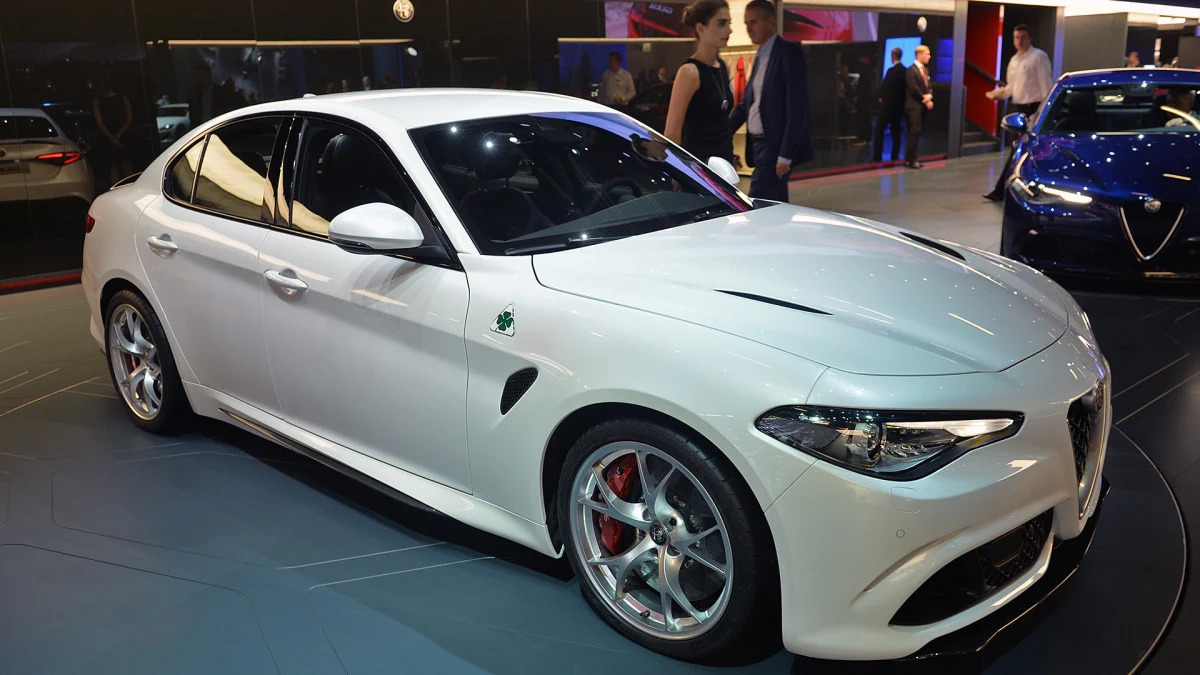Damn it, Alfa Romeo. You had one job. One job. Just return to the North American market. That's it. And just when we thought that long-awaited event was actually in sight, thanks to the new, high-performance Giulia Quadrifoglio sedan, we're being forced to report what we've reported so, so many times before – Alfa's US return has (probably) been delayed.
Citing supplier sources, Automotive News Europe reports that not only has the new Giulia's European launch been delayed six months, to mid 2016, but the Italian brand's first SUV also won't arrive until at least early 2017. That's six and nine months later than each vehicle was expected, respectively. US on-sale dates for both vehicles were slated for at least three to six months after hitting European dealers. If ANE's report is correct, this virtually guarantees we won't see the Giulia Quadrifoglio before autumn 2016/winter 2017, while the Giulia-based SUV's US arrival is effectively pushed back to spring or summer of 2017.
The delay in the Giulia is being blamed on additional work on safety and ride characteristics, ANE's sources claimed. The Quadrifoglio was to be followed by four-cylinder variants in March, but this delay means the high-performance Giulia will be on its own until the end of 2016 in Europe, and early- to mid-2017 in the US. It's unclear if these issues are to blame for the delay in the SUV, although considering it's based in part on the Giulia, that seems like a reasonable assumption.
Naturally, and we're guessing annoyingly for Fiat Chrysler executives, this latest delay is raising further questions about the company's long-term plan for its troubled Turin-based brand. ANE quoted multiple analysts who called out Sergio Marchionne's overly ambitious plans for Alfa, although Morningstar's Richard Hilgert said it best:
"I would be impressed if the brand sold 200,000 [units per year]," Hilgert told ANE. "I think Marchionne set an overly-lofty target as a shock treatment to a patient in cardiac arrest. The idea being to get an immediate dramatic response, but his plan for 400,000 units in 2018 would have the patient immediately get up and run a five-kilometer race."
Related Video:
Citing supplier sources, Automotive News Europe reports that not only has the new Giulia's European launch been delayed six months, to mid 2016, but the Italian brand's first SUV also won't arrive until at least early 2017. That's six and nine months later than each vehicle was expected, respectively. US on-sale dates for both vehicles were slated for at least three to six months after hitting European dealers. If ANE's report is correct, this virtually guarantees we won't see the Giulia Quadrifoglio before autumn 2016/winter 2017, while the Giulia-based SUV's US arrival is effectively pushed back to spring or summer of 2017.
The delay in the Giulia is being blamed on additional work on safety and ride characteristics, ANE's sources claimed. The Quadrifoglio was to be followed by four-cylinder variants in March, but this delay means the high-performance Giulia will be on its own until the end of 2016 in Europe, and early- to mid-2017 in the US. It's unclear if these issues are to blame for the delay in the SUV, although considering it's based in part on the Giulia, that seems like a reasonable assumption.
Naturally, and we're guessing annoyingly for Fiat Chrysler executives, this latest delay is raising further questions about the company's long-term plan for its troubled Turin-based brand. ANE quoted multiple analysts who called out Sergio Marchionne's overly ambitious plans for Alfa, although Morningstar's Richard Hilgert said it best:
"I would be impressed if the brand sold 200,000 [units per year]," Hilgert told ANE. "I think Marchionne set an overly-lofty target as a shock treatment to a patient in cardiac arrest. The idea being to get an immediate dramatic response, but his plan for 400,000 units in 2018 would have the patient immediately get up and run a five-kilometer race."
Related Video:










Sign in to post
Please sign in to leave a comment.
Continue